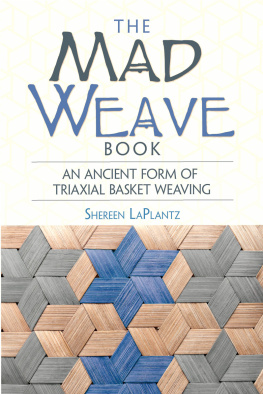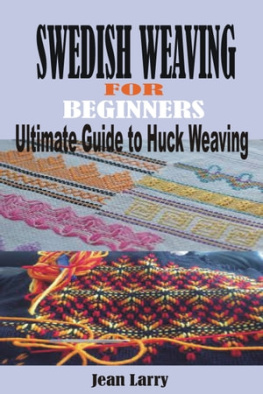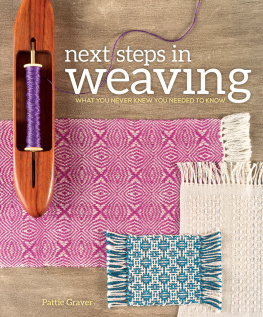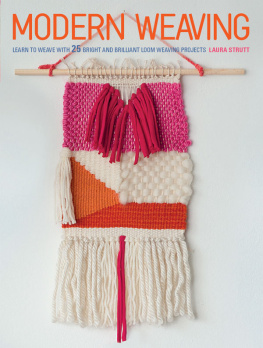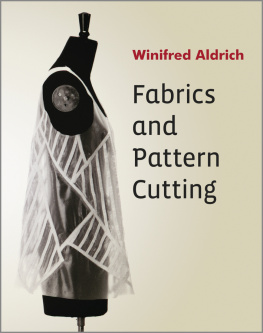Rabbit Goody - Pattern Weaving: Basics for the Handloom
Here you can read online Rabbit Goody - Pattern Weaving: Basics for the Handloom full text of the book (entire story) in english for free. Download pdf and epub, get meaning, cover and reviews about this ebook. year: 2012, publisher: Stackpole Books, genre: Home and family. Description of the work, (preface) as well as reviews are available. Best literature library LitArk.com created for fans of good reading and offers a wide selection of genres:
Romance novel
Science fiction
Adventure
Detective
Science
History
Home and family
Prose
Art
Politics
Computer
Non-fiction
Religion
Business
Children
Humor
Choose a favorite category and find really read worthwhile books. Enjoy immersion in the world of imagination, feel the emotions of the characters or learn something new for yourself, make an fascinating discovery.
- Book:Pattern Weaving: Basics for the Handloom
- Author:
- Publisher:Stackpole Books
- Genre:
- Year:2012
- Rating:3 / 5
- Favourites:Add to favourites
- Your mark:
- 60
- 1
- 2
- 3
- 4
- 5
Pattern Weaving: Basics for the Handloom: summary, description and annotation
We offer to read an annotation, description, summary or preface (depends on what the author of the book "Pattern Weaving: Basics for the Handloom" wrote himself). If you haven't found the necessary information about the book — write in the comments, we will try to find it.
Pattern Weaving: Basics for the Handloom — read online for free the complete book (whole text) full work
Below is the text of the book, divided by pages. System saving the place of the last page read, allows you to conveniently read the book "Pattern Weaving: Basics for the Handloom" online for free, without having to search again every time where you left off. Put a bookmark, and you can go to the page where you finished reading at any time.
Font size:
Interval:
Bookmark:
Yarn and Equipment Suppliers
Yarn
Halcyon Yarn
www.halcyonyarn.com
(800) 341-0282
Harrisville Designs
www.harrisville.com
(603) 827-3333 or (800) 338-9415
Jagger Spun
www.jaggeryarn.com
(207) 324-4455, ext. 26
R&M Yarns
www.rmyarns.com
(800) 343-9276
UKI Supreme Cotton
www.ukisupreme.com
(888) 604-6975
WEBS Yarn
www.yarn.com
(800) 367-9327
Equipment Suppliers
Leclerc Looms
www.leclerclooms.com
(819) 362-7207
Mountain Loom Company
www.mtnloom.com
(360) 295-3856
Schacht Spindle Company Inc.
www.schachtspindle.com
(303) 442-3212
Weaving Programs
Fiberworks
www.fiberworks-pcw.com

Copyright 2012 by Stackpole Books
Published by
STACKPOLE BOOKS
5067 Ritter Road
Mechanicsburg, PA 17055
www.stackpolebooks.com
All rights reserved, including the right to reproduce this book or portions thereof in any form or by any means, electronic or mechanical, including photocopying, recording, or by any information storage and retrieval system, without permission in writing from the publisher. All inquiries should be addressed to Stackpole Books.
Printed in the United States of America
10 9 8 7 6 5 4 3 2 1
FIRST EDITION
Cover design by Wendy Reynolds
Cover photo by Richard Walker
Library of Congress Cataloging-in-Publication Data
Goody, Rabbit.
Pattern weaving : basics for the handloom / Rabbit Goody ; photography by Richard
Walker. First Edition.
pages cm ISBN 978-0-8117-0053-5 (pbk.)
1. Hand weaving. 2. Handlooms. I. Title.
TT848.G667 2012
746.42dc23
2012015836
eBook ISBN 978-0-8117-4884-1
Introduction
I n its most elementary form, weaving is a binary process that involves the crossing of vertical or lengthwise yarns, the warp thread, with horizontal or width-wise yarns, the filling, or weft threads. The horizontal yarns go either over or under the vertical yarns in a set pattern or sequence that generates a design. The tool used to produce the woven object is the loom, operated by the weaver.
How is weaving different from knitting or other fabric construction? Weaving creates fabric that can be easily cut and sewn. It is also an efficient way to produce multiplesseveral scarves, blankets, placemats, and so on.
With weaving, you can make patterns that are an integral part of the cloth, not simply something printed on the surface. And weaving is highly versatile from a design standpoint: You can make patterns with color but also with weave structure, or with combinations of both.
This book on basic pattern weaving will teach you all the steps you need to weave on a foot-treadle handloom. The tips and variations will help you to explore your own creative weaving ideas and give you a firm understanding of the whys and hows of handweaving. It is set up to familiarize you with common patterns and weave structures, but it is not strictly a cookbook of designs.
There are four projects in this book with complete directions, but when you finish it, you will understand how to use the weave structures and techniques from each of these projects to make a wide variety of other items and to explore your own ideas in pattern weaving.
I dont have a clear understanding of why I began weaving, but I know that I have a natural affinity for it. I somehow understood weaving before I ever began to weave. I was part of the hippie generation and the back-to-the-land movement of the 1960s and 70s, and I wanted to build my own house, grow my own food, and make my own clothing. (I have, in fact, done all that.) But I began making my clothing by spinning, using a drop spindle made from a stick and a potato. When I started weaving, I understood how weaving worked in the same way that someone who picks up a musical instrument can just simply play that instrument without being formally taught. I think of weaving and my relationship to it as a part of the human consciousness. Making cloth is innately human. In addition to food and shelter, every culture makes some form of clothing.
I have been working as a professional weaver for more than thirty-five years, both as an independent trade crafter and as a museum interpreter and curator. As a professional weaver in the 1970s, making a living by my craft, I was sure that there were better ways to efficiently weave cloth than the methods that were being taught by revival handweavers to each other. What seemed to be missing was an efficiency and a complexity of production that existed in the seventeenth and eighteenth centuries, when handweaving was the only way that fabrics were produced.
I was fortunate that I worked in the historical museum field and had access to collections of rare books and tools that allowed me to understand the technology of French, German, and English weavers from the sixteenth century forward. What I realized was that much of the historical weavers information had been incorporated into the textile trades and the textile industry, but it was ultimately lost to the modern handweaver.
Today handweaving has become an art form as well as a trade. I stand with a foot in two worlds: one in the world of the handweaver producing beautiful and useful textiles and one in the world of the trade weaver running a craft shop in much the same way that weavers in the late eighteenth and early nineteenth centuries did.
I weave on many types of handlooms and power looms. Some of our equipment is old and recycled power looms that were run on flat belts from stationary engines. Our more modern mechanical jacquard from the 1960s originally was making fabrics for automobiles. I weave on barn-frame looms and on a Weavebird (LeClerc) computer-controlled handloom.
Much of my weaving work is the reproduction of textiles from the past, but my interest is also in how textiles were produced using the equipment of earlier time periods. My focus then is in process and methods.
The goal of this book is to teach methods of production and the process of basic pattern weaving that will allow readers to create whatever textiles they want with the efficiency and quality that empowers them.

The Loom and Other
Pattern-Weaving Tools
Four-Harness Foot-Treadle Loom
This book uses a four-harness jack loom, but it does not matter what loom you are using. The basics of weaving on a foot-treadle harness loom are the same. There are three basic types of looms, all characterized by the movement of the harnesses, also called shafts. There is one kind in which the harnesses are raised when you step on a treadle, another kind in which the harnesses are lowered when you step on a treadle, and a third kind in which some harnesses are raised while the others are being lowered. The important function of the harnesses is to make a division between the threads you will send your shuttle over and the threads you will send your shuttle under. It does not matter for basic weaving how that is accomplished. All looms have the same basic parts. The photo diagrams on the following pages will help you familiarize yourself with the parts of the loom and their functions.
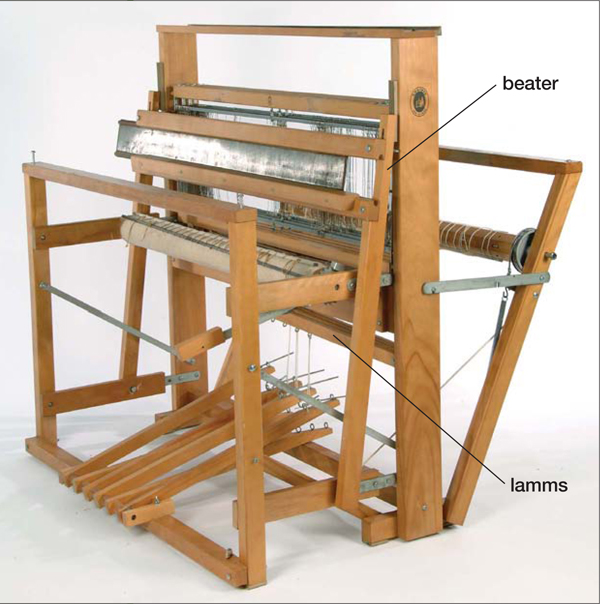
Warp beam: The length of the warp is stored here before it is woven.
Next pageFont size:
Interval:
Bookmark:
Similar books «Pattern Weaving: Basics for the Handloom»
Look at similar books to Pattern Weaving: Basics for the Handloom. We have selected literature similar in name and meaning in the hope of providing readers with more options to find new, interesting, not yet read works.
Discussion, reviews of the book Pattern Weaving: Basics for the Handloom and just readers' own opinions. Leave your comments, write what you think about the work, its meaning or the main characters. Specify what exactly you liked and what you didn't like, and why you think so.


